|
 |
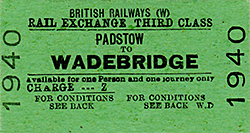 |
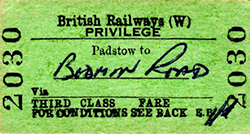 |
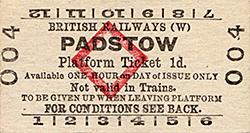 |
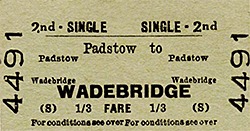 |
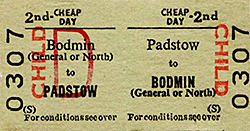 |
old91.jpg) A view of the jetty at Padstow when in its original form. The date is unknown but is probably circa WWI. The jetty has gas lighting, necessary as vessels would arrive at all hours depending upon tides, and a single railway siding terminating, wisely, at buffer stops. The jetty was apparently approached on a very sharp curve at this time. The jetty was later considerably lengthened, given two sidings which divided on the jetty from a single track and provided with a weighbridge. The wagon partly visible on the right is a LSWR 10-ton 5-plank type and probably of what the then yet-to-be-formed Southern Railway designated Diagram 1309. The fishing vessel on the left has not sunk but is sitting on its keel as it is low tide. Vessels so-poised at low tide were and still are a common sight. A keel is located at the very bottom of the hull and is the backbone from which the rest of the hull is built.
A view of the jetty at Padstow when in its original form. The date is unknown but is probably circa WWI. The jetty has gas lighting, necessary as vessels would arrive at all hours depending upon tides, and a single railway siding terminating, wisely, at buffer stops. The jetty was apparently approached on a very sharp curve at this time. The jetty was later considerably lengthened, given two sidings which divided on the jetty from a single track and provided with a weighbridge. The wagon partly visible on the right is a LSWR 10-ton 5-plank type and probably of what the then yet-to-be-formed Southern Railway designated Diagram 1309. The fishing vessel on the left has not sunk but is sitting on its keel as it is low tide. Vessels so-poised at low tide were and still are a common sight. A keel is located at the very bottom of the hull and is the backbone from which the rest of the hull is built.
Photo
from Jim Lake collection
old56.jpg) In June 1926 Beattie well tank No.0298 waits at Padstow with the 1pm service to Wadebridge. These little 2-4-0WT locomotives began life in 1863 as the 329 class for London suburban services and as built bore only a vague resemblance to the form seen above, not least owing to having open cabs. As was common practice, when traffic grew and trains became heavier larger locomotives were required. As a result the little Beatties were dispersed to sheds outside London but withdrawal of the 85-strong class, of which all bar three had been built by Beyer Peacock, began in 1886 and by 1899 only three remained, one of which was No.298 with the other pair being Nos.314 and 329. New locomotives required numbering and as a result the three remaining Beatties went on the Duplicate list with their numbers prefixed by a '0'. No.298 became No.0298 in June 1898. Thenceforth the survivors became known as the 0298 class. This, however, was only the beginning of the story. The three survivors were sent to the Bodmin and Wadebridge section where they were very suitable for the sharply curved Wenford Bridge branch, a freight-only branch carrying china clay. Here they remained until 1962, more than six decades after their stablemates had gone to the scrapyard. No.0298 eventually became Southern Railway No.3298 in 1933, ten years after formation of the Southern Railway, then becoming British Railways No.30587 in 1948. She survives today, being one of two to have entered preservation, the other being LSWR No.314, BR No.30585. At the time of writing No.30587 could be found on the nearby Bodmin & Wenford heritage railway. She is owned by the National Railway Museum. Work on the Wenford Bridge branch was taken over by ex-GWR pannier tanks and later by Class 08 diesel shunters. It closed in 1983. Back at Padstow in 1926, at far left can be seen an advertisement for Sunlight Soap. The '£1000' was not the price of a bar but a prize offered to anybody who could prove Sunlight Soap was detrimental to the skin. This would have been no easy task, especially in 1926, and as far as is known the prize was never claimed. It was, of course, a publicity stunt which would have brought in profits for Lever Brothers, the manufacturer, far exceeding the value of the prize. Sunlight Soap was, incidentally, responsible for the origin of the village of Port Sunlight. Behind the running-in board is an advertisement for 'table dainties' but unfortunately the name of the business is obscured.
In June 1926 Beattie well tank No.0298 waits at Padstow with the 1pm service to Wadebridge. These little 2-4-0WT locomotives began life in 1863 as the 329 class for London suburban services and as built bore only a vague resemblance to the form seen above, not least owing to having open cabs. As was common practice, when traffic grew and trains became heavier larger locomotives were required. As a result the little Beatties were dispersed to sheds outside London but withdrawal of the 85-strong class, of which all bar three had been built by Beyer Peacock, began in 1886 and by 1899 only three remained, one of which was No.298 with the other pair being Nos.314 and 329. New locomotives required numbering and as a result the three remaining Beatties went on the Duplicate list with their numbers prefixed by a '0'. No.298 became No.0298 in June 1898. Thenceforth the survivors became known as the 0298 class. This, however, was only the beginning of the story. The three survivors were sent to the Bodmin and Wadebridge section where they were very suitable for the sharply curved Wenford Bridge branch, a freight-only branch carrying china clay. Here they remained until 1962, more than six decades after their stablemates had gone to the scrapyard. No.0298 eventually became Southern Railway No.3298 in 1933, ten years after formation of the Southern Railway, then becoming British Railways No.30587 in 1948. She survives today, being one of two to have entered preservation, the other being LSWR No.314, BR No.30585. At the time of writing No.30587 could be found on the nearby Bodmin & Wenford heritage railway. She is owned by the National Railway Museum. Work on the Wenford Bridge branch was taken over by ex-GWR pannier tanks and later by Class 08 diesel shunters. It closed in 1983. Back at Padstow in 1926, at far left can be seen an advertisement for Sunlight Soap. The '£1000' was not the price of a bar but a prize offered to anybody who could prove Sunlight Soap was detrimental to the skin. This would have been no easy task, especially in 1926, and as far as is known the prize was never claimed. It was, of course, a publicity stunt which would have brought in profits for Lever Brothers, the manufacturer, far exceeding the value of the prize. Sunlight Soap was, incidentally, responsible for the origin of the village of Port Sunlight. Behind the running-in board is an advertisement for 'table dainties' but unfortunately the name of the business is obscured.
Copyright photo by HC Casserley
aerial.jpg) The riparian setting of Padstow station and its environs in July 1930. Aerial views such as this are useful for getting one's bearings when studying various ground-level photographs. At bottom left we can see the, then, turntable road beyond which lies Messrs Pawlyn Brothers fish curing depot and stores with more buildings being added-to alongside the building seen in earlier photos. Also clearly seen is the goods shed and its pre-1933 track layout, together with a van, probably for cattle, at the dock just beyond the shed. The passenger station is clearly seen and needs no elaboration; the signal box is seen at the end of the platform and the small building behind the box is the lamp room. Beyond the far end of the platform and on the low level road is an early motor vehicle. Under magnification it has a very distinctive style of bodywork, telling is it is a charabanc; an early form of motor coach with open sides and a roof which could be folded back in fine weather. Early examples usually, but not always, had seating which was set higher along the length of the vehicle in similar manner to raked theatre seating. Prominent in the centre of the picture is the railway jetty which had been extended over the years and had two railway sidings. To its left the fish shed can be seen and the West Quay with its sidings curving round towards, but not extending onto, South Quay. Two further sidings run along the outer wall of the dock. At the extreme top right part of Padstow Harbour can be seen. As always the Metropole Hotel presides over the scene, the side of the building being its rear.
The riparian setting of Padstow station and its environs in July 1930. Aerial views such as this are useful for getting one's bearings when studying various ground-level photographs. At bottom left we can see the, then, turntable road beyond which lies Messrs Pawlyn Brothers fish curing depot and stores with more buildings being added-to alongside the building seen in earlier photos. Also clearly seen is the goods shed and its pre-1933 track layout, together with a van, probably for cattle, at the dock just beyond the shed. The passenger station is clearly seen and needs no elaboration; the signal box is seen at the end of the platform and the small building behind the box is the lamp room. Beyond the far end of the platform and on the low level road is an early motor vehicle. Under magnification it has a very distinctive style of bodywork, telling is it is a charabanc; an early form of motor coach with open sides and a roof which could be folded back in fine weather. Early examples usually, but not always, had seating which was set higher along the length of the vehicle in similar manner to raked theatre seating. Prominent in the centre of the picture is the railway jetty which had been extended over the years and had two railway sidings. To its left the fish shed can be seen and the West Quay with its sidings curving round towards, but not extending onto, South Quay. Two further sidings run along the outer wall of the dock. At the extreme top right part of Padstow Harbour can be seen. As always the Metropole Hotel presides over the scene, the side of the building being its rear.
Click here for a larger version.
Reproduced with the kind permission of Simmons Aerofilms Ltd
aerial2.jpg) A July 1930 aerial view looking north-west across Padstow and with the railway station and fish shed just off the picture to the left. The station's north end platform ramp can be seen extreme left. Prominent is the railway jetty which would soon be modified again with a rounded end. This would have been done for a number of reasons including to lessen damage by tidal currents and from collisions. Rather unusually, at the bufferstops north of the station nothing is stabled, while a number of wagons can be seen on the quayside lines and adjacent to the road. Under magnification one appears to be of GWR ownership while another is lettered 'SR' and another 'LMS'. The wagon at the south end of the rake appears at first glance to have derailed but this is merely an illusion caused by a shadow on its load. The small white building at the north end is a toilet. The Metropole hotel, the postal address of which is Station Road, Padstow, stands left of centre and below it between the sidings and the quay is what looks like a number of grounded cattle wagon bodies. The single storey building to the right of the wagons and facing the river is the, then, Fishermen's Mission while at the far end, on the corner opposite the inner harbour as the road turns westwards, the Custom House stands. Many of the buildings seen in the righthand half of the picture would have in some way been connected with harbour and the fishing industry including residential. Certain other buildings are rather distinctive, for example just beyond the Metropole is what is clearly a garage (the long single stored pitched roof building). Perhaps a reader will be able to inform us about some of the other more distinctive buildings. Click here for a larger version.
A July 1930 aerial view looking north-west across Padstow and with the railway station and fish shed just off the picture to the left. The station's north end platform ramp can be seen extreme left. Prominent is the railway jetty which would soon be modified again with a rounded end. This would have been done for a number of reasons including to lessen damage by tidal currents and from collisions. Rather unusually, at the bufferstops north of the station nothing is stabled, while a number of wagons can be seen on the quayside lines and adjacent to the road. Under magnification one appears to be of GWR ownership while another is lettered 'SR' and another 'LMS'. The wagon at the south end of the rake appears at first glance to have derailed but this is merely an illusion caused by a shadow on its load. The small white building at the north end is a toilet. The Metropole hotel, the postal address of which is Station Road, Padstow, stands left of centre and below it between the sidings and the quay is what looks like a number of grounded cattle wagon bodies. The single storey building to the right of the wagons and facing the river is the, then, Fishermen's Mission while at the far end, on the corner opposite the inner harbour as the road turns westwards, the Custom House stands. Many of the buildings seen in the righthand half of the picture would have in some way been connected with harbour and the fishing industry including residential. Certain other buildings are rather distinctive, for example just beyond the Metropole is what is clearly a garage (the long single stored pitched roof building). Perhaps a reader will be able to inform us about some of the other more distinctive buildings. Click here for a larger version.
Reproduced with the kind permission of Simmons Aerofilms Ltd
aerial.jpg) An August 1932 aerial view of Padstow station and harbour areas. Towards the bottom the goods shed is seen and the loop siding bypassing it with, above it, the signal box, lamproom and cattle dock. A little further north sits the station building. On the right is the turntable, this being still the 50ft example and at the site to which it was relocated in 1914. The motley collection of buildings beyond the turntable belonged to Messrs Pawlyn and comprise a fish curing depot and stores. The central, larger, building was possibly relocated from a site behind the fish shed but this is by no means confirmed. The taller building with a vented roof would have been their vented smoke house and was known locally as the 'kipper building'. The fish shed, extended from its original length, is the large building in the centre of the scene. Centre right is the railway jetty with its, by now, two sidings and extended length. Access to the jetty was the reason for resiting the turntable. There was also a weighbridge at its southern end. The jetty was destined to be altered again by the widening of its outer end. Left of centre are the sidings on the quayside. The land where the quay turns north-east, i.e. the harbour wall, was reclaimed and hence the patch of lower level; the small building seen there is a toilet. As usual there are a number of wagons and vans scattered around but little sign of activity at the passenger station. To the right of the inner harbour, top left, and in front of the black shed at least two unidentified road motor coaches are parked. Towards top left the Metropole Hotel can be seen and opposite the wagons on the quay and at the point where the sidings curve to the left stands the, then, Fishermen’s Mission. One further observation is the complete lack of road vehicles of any form in the area around the passenger station and goods yard with the only sign of life being one, maybe two, pedestrians towards the top of the station approach road. Click here for a larger version.
An August 1932 aerial view of Padstow station and harbour areas. Towards the bottom the goods shed is seen and the loop siding bypassing it with, above it, the signal box, lamproom and cattle dock. A little further north sits the station building. On the right is the turntable, this being still the 50ft example and at the site to which it was relocated in 1914. The motley collection of buildings beyond the turntable belonged to Messrs Pawlyn and comprise a fish curing depot and stores. The central, larger, building was possibly relocated from a site behind the fish shed but this is by no means confirmed. The taller building with a vented roof would have been their vented smoke house and was known locally as the 'kipper building'. The fish shed, extended from its original length, is the large building in the centre of the scene. Centre right is the railway jetty with its, by now, two sidings and extended length. Access to the jetty was the reason for resiting the turntable. There was also a weighbridge at its southern end. The jetty was destined to be altered again by the widening of its outer end. Left of centre are the sidings on the quayside. The land where the quay turns north-east, i.e. the harbour wall, was reclaimed and hence the patch of lower level; the small building seen there is a toilet. As usual there are a number of wagons and vans scattered around but little sign of activity at the passenger station. To the right of the inner harbour, top left, and in front of the black shed at least two unidentified road motor coaches are parked. Towards top left the Metropole Hotel can be seen and opposite the wagons on the quay and at the point where the sidings curve to the left stands the, then, Fishermen’s Mission. One further observation is the complete lack of road vehicles of any form in the area around the passenger station and goods yard with the only sign of life being one, maybe two, pedestrians towards the top of the station approach road. Click here for a larger version.
Reproduced with the kind permission of Simmons Aerofilms Ltd
2aerial.jpg) An August 1932 aerial view looking north-west across Padstow and with the railway station on the left, below which the fish shed is seen and, bottom left, Messrs Pawlyn's premises. Prominent is the railway jetty which would soon be modified again with a rounded end. This would have been done for a number of reasons including to lessen damage by tidal currents and from collisions. A motor car can be seen driving onto the station forecourt. At the buffer stops north of the station some passenger stock is stabled, while a number of wagons can be seen on the quayside lines. One appears to be an ex-LSWR goods brake. These have been described elsewhere and were a cross between a goods van and a brake van. Among the other wagons on this siding, at least one is private owner and another bears Southern Railway livery; these details are, however, visible only under magnification. The Metropole hotel, the postal address of which is Station Road, Padstow, is at top centre and below it between the sidings and the quay is what look like a number of grounded cattle wagon bodies. Between the south end of the fish shed and the quay stands a grounded carriage body with yet more beyond and sitting parallel to the end of the shed. The small, white pitched roof building between fish shed and quay belonged to Messrs Pawlyn. Moving along, to the lower right of the Metropole and directly behind the wagons on the quay stands the Fishermen’s Mission while at the far end, on the corner opposite the inner harbour, stands the Custom House. This building is today a hotel. A Custom House could be found at any port where ocean-going vessels have access. There is today no dedicated customs presence at Padstow, the function being handled from elsewhere. Click here for a larger version.
An August 1932 aerial view looking north-west across Padstow and with the railway station on the left, below which the fish shed is seen and, bottom left, Messrs Pawlyn's premises. Prominent is the railway jetty which would soon be modified again with a rounded end. This would have been done for a number of reasons including to lessen damage by tidal currents and from collisions. A motor car can be seen driving onto the station forecourt. At the buffer stops north of the station some passenger stock is stabled, while a number of wagons can be seen on the quayside lines. One appears to be an ex-LSWR goods brake. These have been described elsewhere and were a cross between a goods van and a brake van. Among the other wagons on this siding, at least one is private owner and another bears Southern Railway livery; these details are, however, visible only under magnification. The Metropole hotel, the postal address of which is Station Road, Padstow, is at top centre and below it between the sidings and the quay is what look like a number of grounded cattle wagon bodies. Between the south end of the fish shed and the quay stands a grounded carriage body with yet more beyond and sitting parallel to the end of the shed. The small, white pitched roof building between fish shed and quay belonged to Messrs Pawlyn. Moving along, to the lower right of the Metropole and directly behind the wagons on the quay stands the Fishermen’s Mission while at the far end, on the corner opposite the inner harbour, stands the Custom House. This building is today a hotel. A Custom House could be found at any port where ocean-going vessels have access. There is today no dedicated customs presence at Padstow, the function being handled from elsewhere. Click here for a larger version.
Reproduced with the kind permission of Simmons Aerofilms Ltd
old73.jpg)
mention of garages.
Photo from Malcolm McCarthy collection
old100.jpg)
Photo from Malcolm McCarthy collection
old76.jpg)
Photo from Malcolm McCarthy collection
old77.jpg)
old78.jpg)
Photo from Malcolm McCarthy collection
old43.jpg)
Some investigation has enabled this idyllic scene to be identified. The train has just departed Padstow and is approaching Dennis Hill. The area off the picture to the left of the underbridge is today Dennis Cove Campsite. The River Camel can be seen on the right, and the train will shortly cross Little Petherick Creek bridge which is some 400yd behind the photographer. Although not visible here, an enlargement of the original photograph shows some of the buildings of Padstow are just discernible in the background right of centre. The photograph dates from Southern Railway days and the locomotive is one of the Beattie well tanks. It is displaying the headcode for Bodmin. The train, partly obscured by steam, appears to comprise a 6-wheel brake, a bogie coach and a goods van, the latter likely carrying fish. Of note here is the well maintained permanent way, cutting and hedge. Perhaps not immediately obvious is that a footpath crosses the line adjacent to the bridge, and a gate is just visible at far left of the picture. With the exception of the Camel Trail having replaced the railway, this scene is still recognisable today.
Photo from Malcolm McCarthy collection
Click here for Padstow Gallery 5: c1930s - Early BR

|
| Last updated: Wednesday, 07-Mar-2018 14:50:27 CET | © 1998-2016 Disused Stations |

 Home Page
Home Page